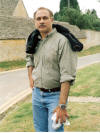|
|
the-south-asian.com July / August 2006 |
|
|||
|
August/September Contents
Sufis - wisdom against 50
years of mountain Heritage cities:
Cotton - the fibre of
|
|
||||
|
Page
1 of 3 BASANT - 'A sky without frontiers' - the Spring Festival of Kites by
First published in March 2002
From mid-January to mid-February the clear blue skies over Punjab, Rajasthan and Gujarat in India, and Lahore in Pakistan, come alive with the gaiety and colour of paper kites – in all hues, shapes and sizes. Kite flying in the Punjab is associated with Vasant Panchami – the onset of spring. It is also commonly known as Basant. The yellow of mustard flowers and the Amaltas trees is the first colour to be sighted after the severe winters of the north. Traditionally, on this day- 5th of the lunar month of Magh – children and women wear yellow – and men folk in Rajasthan wear yellow turbans. Spring heralds new beginnings and the colourful kites in the sky are a statement of this joyous awakening. Basant had its beginnings as a Hindu festival but as different religions came to India they participated in the joy of the occasion and Basant became a truly secular festival – the kites in the sky know no boundaries. Many a musical raga and raagini have been inspired by Magh (Spring). Poets have penned romantic verses, and artists, both of the past and contemporary, have painted the Basant skies.
In Punjab, kite flying is a rooftop sport. The rooftops of inner cities turn into virtual arenas of kite flying competitions on Basant. In Rajasthan and Gujarat kite flying gathers a frenzied momentum on January 13, also celebrated as Makar Sankrant – the day the sun changes direction and starts to move towards the northern hemisphere. In Lahore it is a 24-hour spectacle – it pioneered night kite flying – using strong beams and white kites. Little wonder that Lahore is the official kite flying capital of Pakistan. It is where Basant is celebrated with unmatched passion and zeal. There is no official Basant day here – there is an entire Basant season of kite flying accompanied my rooftop dinners, dances and fun. It is a sort of Octoberfest, a local Mardi Gras or the Rio Carnival minus the revealing dresses. The streets, parks and the roof tops especially are filled with cries and cheers of "Bo Kata" or Kite down, followed by drums rolls.
In Jodhpur, the run-up to Makar Sankrant is celebrated as the International Kite Festival. Maharaja Gaj Singh of Jodhpur [ also the Chairman of Rajasthan Tourism Development Corporation] hosts it every year in the Umaid Bhavan palace lawns. About 75 fliers from 7 countries participate - with teams from Belgium, France, Hongkong, U.K., Japan, Korea, Indonesia, Pakistan and about 7 teams from Jodhpur and Delhi, Pune, Jaipur. Only in 1998 did the team from Hong Kong defeat the Jodhpur " Fateh Sagar Kite Club" [ score 4-2] In all the other years Indian teams have held the crown. The theme of the kite festival is "One-Sky-One World". This is very relevant in this age of confrontation . A sky without borders. There are awards for the most creative kite, [Indian & foreign], best flying display, technological innovation, beauty & delicacy of design.
Pictures given here of the Desert Kite Festival are reproduced with permission from the sites of Mr. Masami Takakuwa of [ www.ashai-net.or.jp/et3m-tkkw/india.html] Japan & Ms.Gina Hsiung of California State University [ www.csun.edu/~hfoao033/fighters2.html] . Other pictures are from Mr.Jamie-Al-Nasir, U.K. web site [ www.al-nasir.com/guide2Pakistan/kites/ ]
|
|||||
|
Copyright © 2000 - 2006 [the-south-asian.com]. Intellectual Property. All rights reserved. |
|||||





